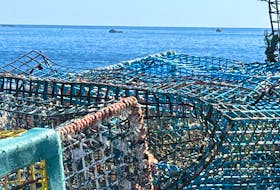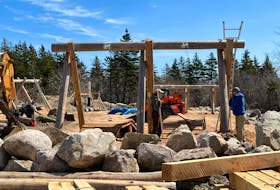It was the noise.
The unrelenting, ear-splitting, mind-scrambling noise.
That noise is indelibly forged in Fred Turnbull’s memory 75 years after he manned the bow of the landing craft that brought Chaudiere regiment troops to Juno Beach in Normandy in the early morning hours of D-Day.
“When I think of the landing, I think of noise,” said Turnbull, a leading seaman from Montreal who now lives in Bedford.
“It was so damn noisy, my hearing went and I think all of us ended up with hearing aids. That was the biggest thing about Normandy. As we went in, the British cruisers were firing on the shore, the Germans were firing back.”
Allied battleships fired over the beach and the Germans returned fire from their inland trenches.
“There was a church steeple with German snipers in it and the air force was coming in trying to hit that steeple.”
In his 2007 book, The Invasion Diaries, Turnbull describes the perilous manoeuvring through German mine explosives set in the water near the Normandy coast.
“We were told of the minefields guarding the beaches and as we moved in at half speed ahead, the mines could be seen spread out for a distance of 500 yards, all very close, making it seemingly impossible for an LCA (landing craft assault) to get through,” Turnbull wrote.

He recounts looking over the bow to see the dead bodies of Allied marine commandos floating in the water.
“I realized what we were facing. The marines were supposed to have cleared the way for us. We were soon weaving through the minefield, and with a strong tide pushing our stern within … inches of each mine, I was ready at any moment to be blown sky high. To make matters worse, mortars were screaming over the craft and the odd Nazi sniper on shore was trying to find a good target.”
Taking the troops to shore
Weighing about 10 tonnes, an LCA was 12.5 metres long and three metres wide. They were crewed by four or five navy men and could carry 35 fully equipped troops.
Turnbull was a member of the 529th Canadian LCA flotilla on board HMCS Prince David, a converted passenger liner that was among an unprecedented Allied invasion armada of more than 5,000 vessels — torpedo boats, landing craft carriers, gunboats, minesweepers, destroyers, corvettes, cruisers and battle ships — waiting about a dozen kilometres from the Normandy coast. The Prince David could carry six LCAs, three on each side, ready to be lowered into the water.
“My job during the whole war, I was a gunner down in the cockpit and also responsible for opening the ramp. I had a Lewis gun (a light machine gun).
“We’d lower the landing craft and they’d (troops) come down the scrambling nets into the landing craft and it was part of our responsibility to unhook the craft. It was one of the darndest things to do.”
In rough water, with the landing craft bouncing up and down, Turnbull said he could easily have lost a hand or a finger while trying to unhook the landing craft from the carrier.
The D-Day waters were rough, even without the shooting and shelling.
“Some of them were seasick,” Turnbull said of the troops aboard his landing craft. “They didn’t give a damn what was on the shore, they just wanted to get off that landing craft. Landing craft are about 45 feet long and they bounce. I was on the edge of being sick during a few landings. I know how they felt so it didn’t take much to get them off the landing craft. I’d drop the ramp and hit them on the back and Jeez, they were away.”

The remaining Prince David landing craft flotilla didn’t need to drop ramp. They were all destroyed by mines and the troops who survived made their way to the beach through waist-deep water.
The flotilla crews from the four destroyed LCAs were loaded onto Turnbull’s landing craft in an effort to return to the Prince David. But the last surviving LCA of the flotilla was ripped apart by a steel spike deployed by the Germans as a secondary defensive measure. All the crews had to abandon the LCA and were picked up by a tank landing craft, which in turn hit a mine and began to sink.
The crews then scrambled onto another nearby tank landing craft and were able to get back to their ship, which ferried injured and dying troops and crewmen back to England.
“You are trained, you have a job to do and you do it,” Turnbull said of the ordeal. “It’s not until after that you realize, how did I survive. We couldn’t even talk to each other, we were all nerved up after it was over and we were back on the ship. You had a job to do and no matter what the noise, you had to do it.”
In The Invasion Diaries, Turnbull wrote, “the sight of our boys being blown up and the thousands of other sights I saw wouldn’t leave my mind.”
That is not what Turnbull and his Montreal school buddies had in mind when preparing to graduate from high school in 1942.
“As soon as exams were over that year, three or four of us, first we argued about what service we were going into,” he said.
Turnbull was only 17 and he was turned away by the air force.
“I met these other friends of mine and went down to the navy, three of us. We were in.”
From Halifax to 'real adventure'
They trained in the city they grew up in, living and working out of a downtown Montreal barracks. They then got word they were going to Halifax to train in September 1942.
Sitting in his highrise apartment overlooking Bedford Basin, Turnbull swept his hand toward the water glistening in the sun.
“We came down here on the train and this is what we saw, this was full of ships, convoys getting ready. I remember seeing that and saying to myself ‘there really is war.’”
By mid-October, the British navy had sent a memorandum seeking volunteers for combined operations to be trained on landing crafts to take troops ashore for the eventual day the Allies would be back into Europe, Turnbull said.
“It sort of struck me that that would be something different and a real adventure to land under the nose of Hitler and the Germans.”
Turnbull signed up for combined operations duty and to go to Britain for additional training.
“They said you’ll get 30 days’ leave. I said that sounds good. Within 48 hours, the Queen Elizabeth was parked outside and we were put on board and I still haven’t got that 30 days’ leave.”
After extensive training, Turnbull and his colleagues with the 6st flotilla were sent to Sicily aboard another converted passenger liner, making a night landing with the LCAs in June of 1943.
“That was my first experience in action. Some of the other fellas were at Dieppe. They were old guys, in their 20s.”
After D-Day, Turnbull spent the most of July and August of 1944 ferrying troops to and from ships stationed off Normandy. In early 1945, he helped bring troops ashore in Sicily.
Back on the Prince David, the flotilla crew thought they might be dispatched to Japan but instead sailed for Victoria, B.C. Arriving in Canada in March, Turnbull was discharged in October. By the time he was in his early 30s, he had graduated with a Bachelor of Arts degree from McGill, went to work with a trust company, married Grace Noakes and had two children. He also had been fitted with a hearing aid.
Now 94, Turnbull said he used to dwell daily on the war, but not so much anymore.
“We were all sort of in different states. Some of the fellows never recovered. Going to university and getting into something right away, that sort of got it out of your mind.”
D-DAY AT 75: Remembering the heroes and sacrifices of Atlantic Canada:
- VIDEO: The road to D-Day
- Why a school in France is named for a Pictou soldier
- U-boat hunter Roderick Deon returns to Juno Beach for D-Day
- Sound of gunfire rang in P.E.I. soldier’s ears
- North Nova Scotia Highlanders at the sharp end of D-Day invasion
- STORY MAP: Follow the D-Day experience of the North Nova Scotia Highlanders
- 12 North Nova Scotia Highlanders murdered at Abbaye d’Ardenne
- ‘It was noisy as the devil,’ says St. John’s torpedo man
- 59th Newfoundland Heavy Regiment was eager to do its part
- A P.E.I. dispatcher’s long, uncertain journey to Normandy
- LAURENT LE PIERRÈS: D-Day invasion was best birthday present for my Dad
- ‘Sight of our boys being blown up ... wouldn’t leave my mind:’ Bedford veteran, author
- Dartmouth veteran's first combat mission was D-Day invasion
- Halifax air gunner had bird’s-eye view of D-Day
- ‘We had everything fired at us but the galley sink’: Yarmouth County veterans share war and D-Day memories
- New Waterford veteran has lived good life after surviving D-Day invasion
- JOHN DeMONT: An old film clip of D-Day shows the nature of courage
- D-Day landing map’s origins a mystery to army museum historians








